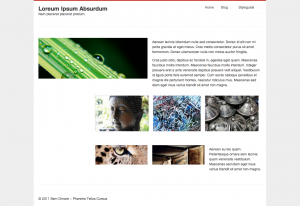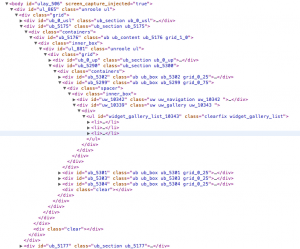Layout Structure
Whether or not you are designing a theme or adding stylesheet or javascript elements to a channel it is useful to know the structure and markup of the HTML code generated by a layout. This code is the same for every layout in the system whether it is generated from a page or channel layout.
On the right are two screeenshots which illustrate a fully formed page and the first part of the generated HTML code for that page. The rendered HTML markup gives many different areas for you to reference when digging deep into the HTML/CSS/JS of a layout. You will notice the clear hierarchy of elements as explained in the Layout Box Model article is generated. You should notice a few conventions that are employed in the markup to make it easier to reference elements or build your own HTML as part of an HTML widget.
If you are working directly with the DOM it is useful to know which classes and id's are automatically generated by the system for use by theme builders or through stylesheets. The table below lists the various attributes, what element they are included in and their purpose.
Common Classes
| Format | Example | Elements | Purpose |
|---|---|---|---|
| ul | Layouts | Indicates the beginning of a layout. If directly after the body, then it can be considered the primary channel layout of the page. If nested deeper than this, it is the content layout of the page. | |
| us | Sections | Used on any section elements. | |
| ub | Boxes | Used on any box elements. | |
| uw | Widgets | Used on any widget elements. | |
| ucl | Channel Layouts | Used on any channel layouts. | |
| up | Pages | Used on any page layouts. | |
| ub_xxxxx | ub_content, ub_box, ub_divider | Boxes | A class used to identify a specific category of boxes such as content, dividers or normal boxes. |
| uw_xxxx | uw_navigation, uw_html, uw_asset | Widgets | A class used to identify a specific category of widgets for global styling. Every widget type has a unique class. |
| grid_x_xx | grid_0_25, grid_1_0, grid_0_10 | Boxes | Used for styling purposes to indicate the type of column width that this box takes up as part of the page. Everything is done in 3 digit rounded percentages. ex: 0_25 = 25% of layout width, 1_0 = 100% of layout width, 0_10 = 10% of layout width. Note that this may not apply if the number of column of a layout is changed without changing the box width. |
Extended Classes
| Format | Example | Elements | Purpose |
|---|---|---|---|
| unroole | Layouts | Legacy tag leftover from previous layout versions (don't use). | |
| grid | Layouts | Indicates the beginning of of a new unroole grid. | |
| ub_section | Sections | A simple class indicating a section sub-division. | |
| containers | Sections | The first element inside any section to be used for styling purposes. | |
| inner_box | Boxes | Used within a box for styling purposes. | |
| spacer | Boxes | Used with themes and stylesheets to help add space between boxes. | |
| ub_xxxx | ub_5289, ub_5296 | Boxes | Due to the fact the id's of boxes can be changed this class allows for referencing of the system id even if changed. |
| uw_xxxx | uw_10342, uw_5876 | Widgets | Due to the fact the id's of widgets can be changed this class allows for referencing of the system id even if changed. |
Common ID's
| Format | Example | Elements | Purpose |
|---|---|---|---|
| ulay_xxx | ulay_506 | Pages, Channel Layouts | Derived from the id of the page or channel layout containing the layout. |
| ul_xxx | ul_865 | Layouts | A unique identifier for this specific version of the layout. Useful for targeting different revisions of a layout. |
| ub_0_usl | Sections | A unique identifier indicating the first section of the channel layout on a rendered page. | |
| ub_0_up | Sections | A unique identifier indicating the first section of the page content on a rendered page. | |
| ub_xxxx | ub_5176, my_box, anything_you_want | Boxes | A unique identifier for this box based on the box properties or auto-generated by the system. |
| uw_xxxx | uw_10342, my_widget, anything_you_want | Widgets | A unique identifier for this widget based on the widget properties or auto-generated by the system. |

